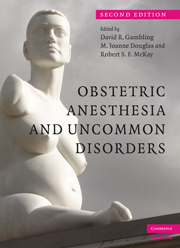Book contents
- Frontmatter
- Contents
- List of plates
- List of contributors
- Preface
- Section 1 Cardiovascular and respiratory disorders
- 1 Structural heart disease in pregnant women
- 2 Disorders of cardiac conduction
- 3 Vascular diseases
- 4 Respiratory disorders in pregnancy
- Section 2 Musculoskeletal disorders
- Section 3 Nervous system disorders
- Section 4 Metabolic disorders
- Section 5 Other disorders
- Index
- Plate Section
- References
1 - Structural heart disease in pregnant women
from Section 1 - Cardiovascular and respiratory disorders
Published online by Cambridge University Press: 19 October 2009
- Frontmatter
- Contents
- List of plates
- List of contributors
- Preface
- Section 1 Cardiovascular and respiratory disorders
- 1 Structural heart disease in pregnant women
- 2 Disorders of cardiac conduction
- 3 Vascular diseases
- 4 Respiratory disorders in pregnancy
- Section 2 Musculoskeletal disorders
- Section 3 Nervous system disorders
- Section 4 Metabolic disorders
- Section 5 Other disorders
- Index
- Plate Section
- References
Summary
Introduction
This chapter will outline the physiological changes, hemodynamic goals, management, and anesthetic options with regards to patients with acquired or congenital structural heart disease during pregnancy, labor, and delivery. There is no consensus as to the optimal anesthetic technique for the conditions being discussed. General and regional anesthesia can have significant cardiovascular effects on a parturient with cardiac disease. In addition, many pharmacological agents commonly used in anesthetic and obstetric practice can have adverse hemodynamic effects (Table 1.1).
Due to the nature and the rarity of the cardiac diseases discussed, there is a lack of randomized controlled studies to guide our practice. As a result, case reports and expert opinion will form the basis of discussing the anesthetic techniques. However, management options and anesthetic techniques must be individualized and based on the prevailing hemodynamic condition and obstetric needs.
Scope of the problem
An estimated 0.2–3.0% of pregnant patients have cardiac disease, an increasing cause of maternal mortality. The 2000– 2 Confidential Enquiries into Maternal Deaths in the United Kingdom reported that cardiac disease was the second most common nonobstetric cause of maternal death after psychiatric disease. Cardiac disease is also more common than the leading direct causes of maternal death. The maternal mortality rate ranges from 0.4% in New York Heart Association (NYHA) class I–II women to 6.8% in class III–IV (Tables 1.2 and 1.3).
- Type
- Chapter
- Information
- Obstetric Anesthesia and Uncommon Disorders , pp. 1 - 28Publisher: Cambridge University PressPrint publication year: 2008



